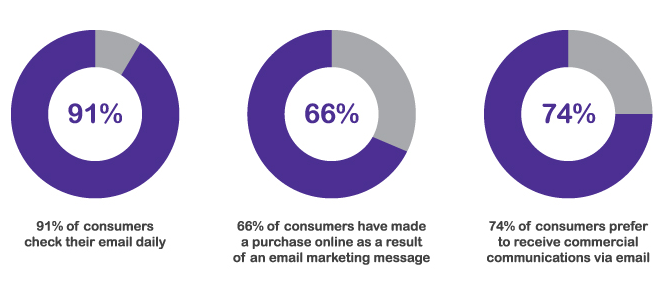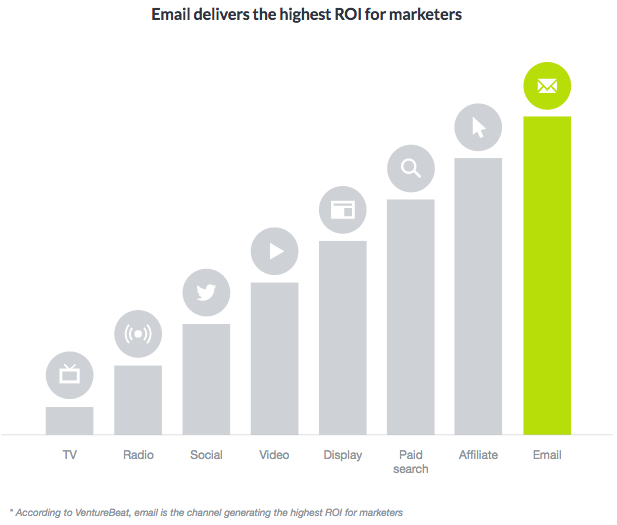SPAM. Even just hearing the word makes you cringe.
Spam email is an irrelevant and non-personalised form of bulk advertising that is unsolicited by the receiver. For many, this online communication is simply unnecessary and undesirable. But, for the sender, it is a cost effective way of distributing mass amounts of marketing material to current and potential consumers.
As of June 2016, 55.7% of email traffic was accounted as global spam. While the volume has decreased significantly over the past two years (in April 2014, 71.1% of worldwide email traffic were spam messages), for most consumers it still remains to be extremely frustrating.
While spam is bad news for everyone and has tainted many forms of online communication, don’t give up hope just yet! Email marketing is still a viable and powerful tool businesses should be utilising.
Why? Well here are a few reasons:
These statistics are certainly convincing, but the winning element of email marketing is its high ROI, which delivers the highest ROI when compared to other platforms.
Interestingly, it was also discovered that when trying to grow a business, acquire new customers, launch a product, or offer a promotion, email marketing was once again the winner. Unlike social media platforms, such as Facebook and Twitter, email marketing was 40 times more effective in acquiring new customers!
Unmistakably, email marketing is an effective channel that can enhance businesses marketing objectives, but it is important to distinguish between sending meaningful content to consumers and spam. But if you’re going to successfully go down the path of email marketing, make sure that the email is tailored to your consumers likes and preferences as 58% of consumers would not open an email if they thought it was irrelevant to them or their needs. Or, in other words, if they thought it was spam!
What are your thoughts? Let me know and pop a comment below 🙂



Good read georgiebrien, can’t really argue with those statistics as I initially thought that email marketing was becoming a lost art, yet given the circumstances, it is still very effective. I guess, the largest problem facing marketers is the point of making email marketing relevant to the consumer and not simply spam; especially as nowadays the Victorian Department of Justice are now constantly online investigating to prevent the promotion of spam. There seems to be a very fine line between the two (spam and promotion); so if only 58% of consumers would not open an email because they thought it was ‘spam’ even if it isn’t, how do you think marketers position their email marketing so they have a higher chance of having their emails being opened or engaged in?
Hey Georgie,
Great post!
I’m definitely part of the 58% of consumers who don’t open their emails. I am inundated with emails every morning, around 7-8 emails that aren’t directly meant to me. From companies such as Jetstar, Hotels.com etc but I never open them. I know they are mass marketing attempts and so it’s not personal enough for me.
I do still think, and research proves this, that email marketing is effective it just needs to be harnessed effectively.
I think these days, personally video is one way that I’m engaging. It’s quick and effective and it talks to me rather than me having to read it to become interested. There’s some fantastic marketing using video I’ve seen displayed on Facebook and Instagram as well as SnapChat which is an up and coming form of innovating marketing.
Loved the post, thanks for sharing your thoughts!
Katie
Thanks for your comment jacksonblogspace!
A strategy marketers can use to position their email marketing, so that they have a higher chance of having their emails read is through segmentation. Looking at their consumers’ previous interactions, marketers have the ability to divide their audience into more targeted groups. For example, they could generate an email list for those consumers wanting product updates, those wishing to receive a newsletter, divide consumers into how often they wish to receive information (ie. daily, weekly, fortnightly or monthly) etc. Let consumers decide how and when they want to be contacted and you’re less likely to lose them!
But also check out this article (http://blog.hubspot.com/marketing/metrics-email-marketers-should-be-tracking#sm.0001meaim366wd4gtwt1nqry9f04p) that offers some more analytical approaches to email marketing and how you can use data generated from your email marketing campaigns to your advantage.
Can you think of any other ways?
🙂
Hi Katie, thanks for your comment!
I totally agree with you that video is engaging, quick, and effective for consumers, especially when used in a way that doesn’t appear to be advertising or a marketing campaign. You mention that there are some great campaigns on Facebook, Instagram, and Snapchat – which ones are your favourite?!
Hey Georgie!
Those are amazing stats!
Every time I open up my inbox I can’t help but think about how the company’s are able to see so many details such as whether I opened it and if I trash it. I will say though heaps of clothing companies have successfully joined me onto their mailing list with irresistible offers such as “receive 10% off when you sign up today!”. I think if company’s keep playing their cards right they can turn casual shoppers into loyal ones all from just sending a couple of emails a week. I find myself caving into clicking onto emails because of catchy titles and they are often really good at enticing you to feel like you need what they have to offer. Companies like these can really benefit from such emails but they better beware of the spam folder! I never take emails seriously when they have been filtered there – straight to the rubbish bin!
Hey Georgie
I agree with your evaluation of spam emailing, it is a very cost effective and worth while form of advertising. The biggest issue other than legal, is trying to get people to sign up however i know that personally even though i promise myself never to sign up to those deals. I can’t walk away from a sign up bonus and now find my inbox filled with spam. At $0.03 cost per 1000 people I can’t blame them for using this form, i would too haha.
Spot on Georgie with email being the most effective tool to convert consumers into customers. Many people forget that while social media can potentially have a huge reach and is useful for brand awareness, getting conversions off platforms like Facebook is very difficult! In saying this there is a fine line between useful content for subscribers and over sending of irrelevant messages, or ‘spam’. At least genuine companies have (or are at least required to by law) an opt-out option if the messages become too annoying, unlike illegal and bulky spam messages sent on a host of products, from Viagra to cheap kicks and scams. These more malicious and genuine (or in-genuine depending on how you look at it) forms of spam only need 1 in 2,000,000 conversions to remain economically viable.
For more Facts and some funny spam videos feel free to check out my blog over at https://sdc123marketing.wordpress.com/2016/10/12/spam-spam-here-i-am/ and let me know in the comments what you think :).
Cheers,
Simon.